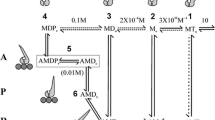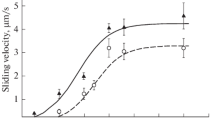Summary
Cat jaw-closing muscles (masseter, posterior and anterior temporalis) are physiologically much faster than fast-twitch muscles of the hind limb. They have a highly oxidative metabolism and contain an alkali-stable ATPase as shown by histochemical staining. These observations have been extended here using immunocytochemical, enzymatic and biochemical analyses of myosin from posterior temporalis muscles. Antisera against posterior temporalis myosin do not precipitate gastrocnemius or soleus muscle actomyosin in Ouchterlony double diffusion. Using enzyme-linked immunoadsorbant, antisera to posterior temporalis myosin do not cross-react with heavy chains from flexor hallucis longus (FHL) or soleus myosin at dilutions where the reaction with posterior temporalis heavy chain is easily detected. Myosin isolated from posterior temporalis has an ATPase activity in the presence of EDTA (K+-ATPase) or calcium ions, that is, more than twice the corresponding value for FHL myosin. The myosin is unusual in its high degree of lability on storage at 0° C: it loses over 25% of the K+-ATPase per day and aggregates readily. Although the myosin is activated over 80-fold by actin, the maximum velocity obtained by extrapolation to saturating actin concentrations is considerably below that obtained for FHL myosin. This probably reflects the marked instability of the myosin rather than its true actin-activated ATPase. An alternative method of comparing actomyosin ATPase activity is by using myofibril preparations. Using conventional procedures it has not been possible to prepare myofibrils from posterior temporalis because of the extensive network of connective tissue surrounding the fibres. More drastic techniques, for example, the mini cell disruption chamber, will disrupt the fibres, but the myofibrils so produced are very small and often highly aggregated. Analysis of the myosin by gel electrophoresis shows that the LC1 and LC2 light chains of posterior temporalis myosin can be distinguished from those of soleus and FHL myosins. Polypeptide mapping of the various heavy chains also shows that posterior temporalis heavy chains are chemically different from those of the hind-limb muscle myosins.
Fast-twitch oxidative fibres have been identified in hind limb and body muscles of the rat, cat and chicken; posterior temporalis myosin differs from these myosins also on the basis of its histochemical properties. We conclude that the myosin of jaw-closing muscles is phenotypically distinct from both fast-twitch oxidative and fast-twitch glycolytic muscles of the body and limbs, though similar ‘super-fast’ fibres may occur elsewhere than in the jaw.
Similar content being viewed by others
References
BACHYRITA, P. & ITO, F. (1966)In vivo studies on fast and slow muscle fibres in cat extraocular muscles.J. gen. Physiol. 49, 1177–98.
BARANY, M. (1967) ATPase activity of myosin correlated with speed of muscle shortening.J. gen. Physiol. 50, 197–216.
BOSLEY, M. & ROWLERSON, A. (1980) A new myosin associated with the fast fibre type in the cat jaw — closer muscles?J. Physiol., Lond. 306, 18P.
BROOKE, M. H. & KAISER, K. K. (1969) Some comments on the histochemical characterisation of muscle adenosine triphosphatase.J. Histochem. Cytochem. 17, 431–2.
BROOKE, M. H. & KAISER, K. K. (1970) Muscle fiber types: How many and what kind?Archs Neurol. 23, 369–79.
BULLER, A. J., MOMMAERTS, W. F. H. M. & SERAYDARIAN, K. (1969) Enzymic properties of myosin in fast and slow twitch muscles of the cat following cross-innervation.J. Physiol., Lond. 205, 581–97.
BURKE, R. E., LEVINE, D. N., TSAIRIS, P. & ZAJAC, F. E., III (1973) Physiological types and histochemical profiles in motor units of the cat gastrocnemius.J. Physiol., Lond. 234, 723–48.
FERENCZI, M. A., HOMSHER, E., SIMMONS, R. M. & TRENTHAM, D. R. (1978a) Reaction mechanism of the magnesium ion-dependent-adenosine triphosphatase of frog muscle myosin and subfragment-1.Biochem. J. 171, 165–75.
FERENCZI, M. A., HOMSHER, E., TRENTHAM, D. R. & WEEDS, A. G. (1978b) Preparation and characterization of frog muscle myosin subfragment-1 and actin.Biochem. J. 171, 155–63.
GAUTHIER, G. F. (1980) Distribution of myosin isoenzymes in adult and developing muscle fibres. InPlasticity of Muscle (edited by PETTE, D.) pp. 83–96. Berlin: de Gruyter.
GAUTHIER, G. F. & LOWEY, S. (1977) Polymorphism of myosin among skeletal muscle fiber types.J. Cell Biol. 74, 760–79.
GAUTHIER, G. F. & LOWEY, S. (1979) Distribution of myosin isoenzymes among skeletal muscle fiber types.J. Cell Biol. 81, 10–25.
GREEN, I. & MOMMAERTS, W. F. H. M. (1953) Adenosine triphosphatase systems of muscle, 1. An electrotitrimetric method of measurement.J. biol. Chem. 202, 541–9.
HAYASHI, M. & FREIMAN, D. E. (1966) An improved method of fixation for formalin-sensitive enzymes with special reference to myosin adenosine triphosphatase.J. Histochem. Cytochem. 14, 577–81.
HEYDERMAN, E. (1979) Immunoperoxidase technique in histopathology: applications, methods and controls.J. clin. Pathol. 32, 971–8.
JOHNSTON, I. A. & GOLDSPINK, G. (1975) Thermodynamic activation parameters of fish myofibrillar ATPase enzyme and evolutionary adaptations to temperature.Nature, Lond. 257, 620–2.
LAEMMLI, J. K. (1970) Cleavage of structural proteins during the assembly of the head of bacteriophage T4.Nature, Lond. 227, 680–5.
LAEMMLI, J. K. & FAVRE, M. (1973) Maturation of the head of bacteriophage T4.J. molec. Biol. 80, 575–99.
LENNERSTRAND, G. (1972) Fast and slow units in extrinsic eye muscle of cat.Acta physiol. scand. 86, 286–8.
LUTZ, H., ERMINI, M., JENNY, E., BRUGGMANN, S., JORIS, F. & WEBER, E. (1978) The size of the fibre populations in rabbit skeletal muscles as revealed by indirect immunofluorescence with anti-myosin sera.Histochemistry 57, 223–35.
MASCARELLO, F., AURELI, G. & VEGGETTI, A. (1979) Muscoli masticatori Determinazione istochimica dei tipi de fibre muscolari in mammiferi. Inquaderni di Anatomia Pratica, Ser. XXXV, pp. 193–211. Padua: Piccin Editore.
MAXWELL, L. C., CARLSON, D. S. & BRANGWYN, C. E. (1980) Lack of acid reversal of myofibrillar adenosine triphosphatase in masticatory muscle fibres of rhesus monkeys.Histochem. J. 12, 209–19.
OFFER, G. W. (1976) The antigenicity of myosin and C-protein.Proc. R. Soc. Lond., Ser. B. 192, 439–49.
OFFER, G. W., MOOS, C. & STARR, R. (1973) A new protein of the thick filaments of vertebrate skeletal myofibrils.J. molec. Biol. 74, 653–76.
POPE, B., HOH, J. F. Y. & WEEDS, A. G. (1980) The ATPase activities of rat cardiac myosin isoenzymes.FEBS Lett. 118, 205–8.
POPE, B., WAGNER, P. D. & WEEDS, A. G. (1981) Studies on the actomyosin ATPase and the role of the alkali light chains.Eur. J. Biochem. 117, 201–6.
REEDY, M. K. (1976) Preservation of X-ray patterns from frog sartorius muscle prepared for electron microscopy.Biophys. J. 16, 126a.
TAYLOR, A. & DAVEY, M. R. (1968) Behaviour of jaw muscle stretch receptors during active and passive movements in the cat.Nature, Lond. 220, 301–2.
TAYLOR, A., CODY, F. W. J. & BOSLEY, M. A. (1973) Histochemical and mechanical properties of the jaw muscles of the cat.Expl Neurol. 38, 99–109.
TAYLOR, R. S. & WEEDS, A. G. (1976) The magnesium ion dependent adenosine triphosphatase of bovine cardiac myosin and its subfragment-1.Biochem. J. 159, 301–15.
WAGNER, P. D. (1981) Formation and characterisation of myosin hybrids containing essential light chains and heavy chains from different muscle myosins.J. biol. Chem. 256, 2493–8.
WAGNER, P. D., SLATER, C. S., POPE, B. & WEEDS, A. G. (1979) Studies on the actin activation of myosin subfragment-1 isoenzymes and the role of myosin light chains.Eur. J. Biochem. 99, 385–94.
WAGNER, P. D. & WEEDS, A. G. (1977) Studies on the role of myosin alkali light chains.J. molec. Biol. 109, 455–73.
WEEDS, A. G. (1976) Light chains from slow twitch muscle myosin.Eur. J. Biochem. 66, 157–73.
WEEDS, A. G. & LOWEY, S. (1971) Substructure of the myosin molecule.J. molec. Biol. 61, 701–25.
WEEDS, A. G., TRENTHAM, D. R., KEAN, C. J. C. & BULLER, A. J. (1974) Myosin from cross-reinnervated cat muscles.Nature, Lond. 247, 135–9.
WHALEN, R. G. (1980) Contractile protein isozymes in muscle development: the embryonic phenotype. InPlasticity of Muscle (edited by PETTE, D.), pp. 177–191. Berlin: de Gruyter.
WHALEN, R. G., BULTLER-RROWNE, G. S. & GROS, F. (1978) Identification of a novel form of myosin light chain present in embryonic muscle tissue and cultured muscle cells.J. molec. Biol. 126, 415–31.
WHALEN, R. G., SCHWARTZ, K., BOUVERET, P., SELL, S. & GROS, F. (1979) Contractile protein isozymes in muscle development: identification of an embroyonic form of myosin heavy chain.Proc. natn. Acad. Sci., U.S.A. 76, 5197–201.
WHALEN, R. G. & SELL, S. M. (1980) Myosin from fetal hearts contains the skeltal muscle embryonic light chain.Nature, Lond. 286, 731–3.
Author information
Authors and Affiliations
Rights and permissions
About this article
Cite this article
Rowlerson, A., Pope, B., Murray, J. et al. A novel myosin present in cat jaw-closing muscles. J Muscle Res Cell Motil 2, 415–438 (1981). https://doi.org/10.1007/BF00711968
Received:
Issue Date:
DOI: https://doi.org/10.1007/BF00711968




